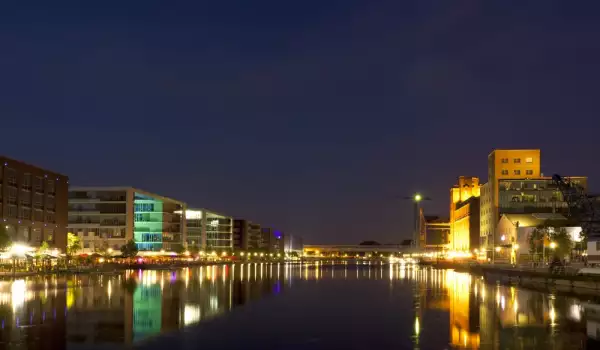Duisburg

The German city of Duisburg is the largest river port, not only in Europe but also worldwide. It is located around the area where the Ruhr River flows into the Rhine.
The city is best known for its brewing traditions, fascinating museum, its industrial cityscapes and attractive docks. In Duisburg is located the University of Duisburg-Essen - one of the most prestigious educational institutions in Germany, where are trained over 30 000 students.

Among the biggest attractions of Duisburg is the local opera. On stage at the cultural center are set fine ballet performances, as well as many theatrical productions. The building is relatively new, is built on the ruins of the destroyed by the bombing of the old Opera Duisburg.
Much of the architectural masterpieces of Duisburg were reduced to rubble during World War II. According to statistics, about 80 percent of all buildings in the city were destroyed. That is why today, in place of demolished old buildings rise modern buildings that embody the spirit of dynamism and modernity.
Among the most attractive museums of Duisburg is the German Inland Waterways Museum, located in the neighbourhood Ruhrort. In the building, erected in 1974, you can learn interesting details about the world's largest river port with 50 million tons of cargo.

Another attractive feature is the Museum of Wilhelm Lehmbruck. The German sculptor was born in Duisburg, is one of the most talented German artists. The Museum has a wonderful combination of exquisite works.
Perhaps the most visited religious shrine is the Church of St. John the Baptist, whose foundations were laid back in the year 900.
As it can be assumed, the German city is home to a large Muslim community. In Duisburg is the largest mosque outside the Islamic countries. The religious shrine Merkez Mosque is one of the landmarks of the city. The minaret of the mosque is 34 meters high. It is built with the assistance of the European Union, in 2008.
In Duisburg is an unusual park - Landschaftspark, which are huge steel and concrete pipe facilities and old furnaces, which rise around young trees and picturesque paths. The idea of the park is to enable visitors to examine closely the large abandoned industrial facilities, to explore their mechanisms of operation, Created in 1991.
Around the port city are two charming botanical gardens. Duisburg has a one thousand one hundred year long history. There is evidence that even in the 5th century BC, the territory of the German city was a vast market. Today the population dynamic Duisburg is about half a million people.
Next to Duisburg are other interesting cities in Germany, namely - Oberhausen, Mülheim an der Ruhr, Ratingen, Düsseldorf, Meerbusch, Krefeld, Moers, Rheinberg and Dinslaken.









